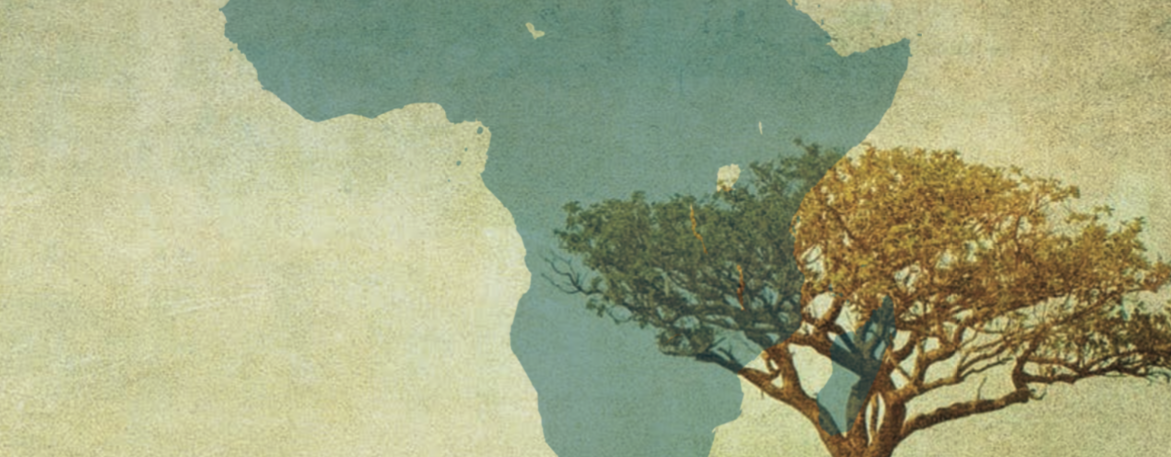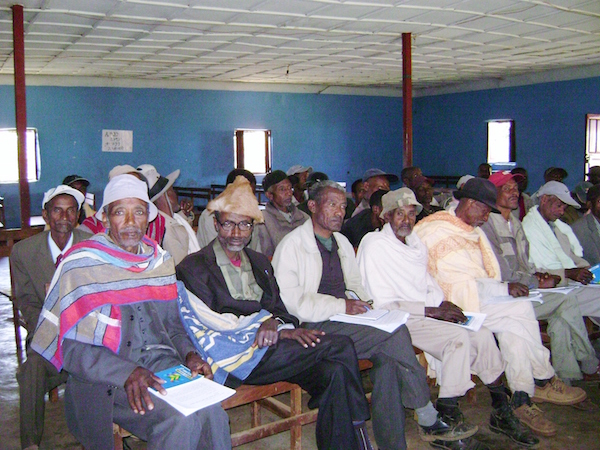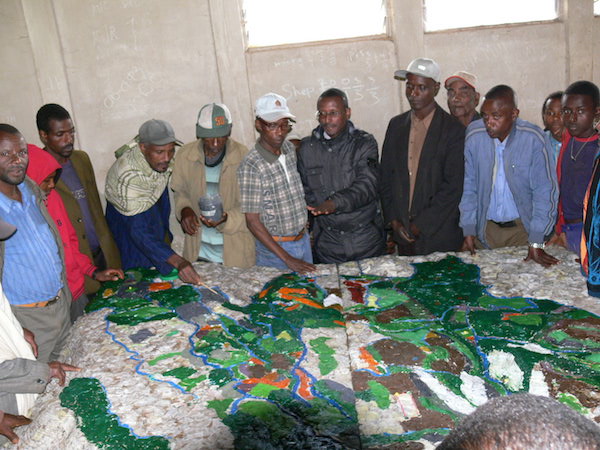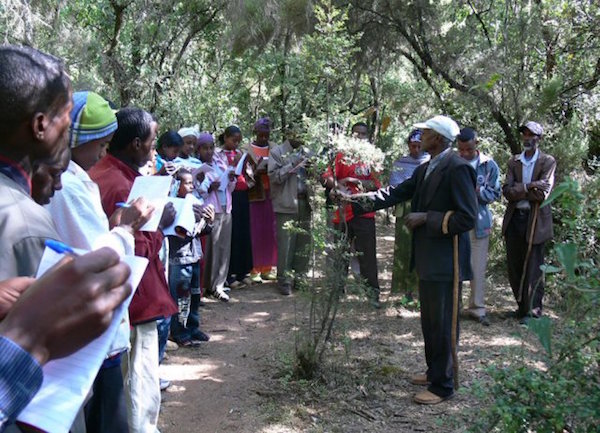
The following case study is an extract from Protecting Community Lands and Resources in Africa, a book of case studies that highlights land rights advocates’ innovative community land protection efforts.
By Mersha Yilma, MELCA-Ethiopia
MELCA-Ethiopia is a non-governmental, non-profit organization established in 2005 under the initiative of lawyers, environmentalists, botanists, and other professionals concerned with the rapid degradation of the culture and environment in Ethiopia. MELCA is currently working in three regions of the country: Oromiya national regional state; Southern Nations, Nationalities and Peoples region; and Gambella national regional state. MELCA works in these regions with the overall objective of supporting local communities in the revival of their cultural values that have a strong connection with conservation of nature and building a resilient community.

Sheka community leaders assemble for a capacity-building meeting with Melca. © MELCA Ethiopia
Ethiopia is one of the world’s most biodiverse countries, with ecosystems ranging from humid forest and extensive wetlands to the desert of the Afar depression. The variation in climate, topography and vegetation has contributed to a rich diversity of both flora and fauna, including valuable reserves of crop genetic diversity. In particular, the extensive and unique conditions in the highlands of the country have contributed to the presence of a large number of endemic species.
Local communities in rural Ethiopia have a culture and practice of living in harmony with nature. The immense traditional ecological knowledge and governance systems in the rural community have been crucial in conserving the country’s biodiversity for generations. However in recent years, long-standing cultural values and traditional rural practices that are crucial to conserving biodiversity have started to erode with the advent and expansion of modern (Western) education, introduction of new religious beliefs, population growth, and changes in government policies and ideologies. These changes in the social and political situation of the country started to result in loss of biodiversity and deterioration of the environment at an alarming rate.
Nationalization of land since 1974 and then the expansion of large-scale agricultural investments since the current Ethiopian Peoples Revolutionary Democratic Front (EPRDF) came into power in 1991 aggravated the situation. The constitutions during both these regimes confer the right to ownership of land to government. Citizens only have “use rights” over any land they hold and can be removed at any time if the government deems the land is needed for national development.
In 2000, a flow of foreign investments and large-scale agricultural projects started to threaten communities in the south-western part of Ethiopia . The land in the area is one of the few remaining fertile areas containing Afromontane natural forests and local communities are highly dependent on the forest for their livelihoods.
The Sheka Zone is an area in the south-western part of Ethiopia in the Southern Nations, Nationalities and Peoples Region (SNNPR). The Sheka Forest has long been the major source of livelihood and spiritual practices in the area and supports diverse wildlife populations. For centuries the natural resources in this area have been successfully managed by traditional protection systems under which strong cultural taboos regulate the use and development of forest resources. The communities earn most of their cash income from honey and spices produced in dense forest. The strong links between communities (the Shekacho, Sheko and Mezenger ethnic groups) and forests, coupled with the large degree of biological and cultural diversity found throughout the area, makes the Sheka Zone an inherently valuable site.
In 2006, MELCA learned of the threats to the forest and livelihoods of the communities in the Sheka Zone. Erosion of culture and traditional governance systems of the local communities meant that the communities were ill-prepared to deal with the threat of expansion of large-scale agricultural investments. In particular, a group called “East African Agribusiness” had been given forestland in Sheka for agricultural investment and had begun clearing the forest for tea plantations.
MELCA-Ethiopia partnered with “Organization for Social Justice Ethiopia” and “Forum for Environment” to form the “Sheka Forest Alliance” to support the communities of Sheka speak out and claim the rights over the forest that they have conserved for generations. The Alliance, later joined by other social and environmental NGOs, agreed on a three-pronged strategy: empowering the local community, improving law enforcement, and working at policy level to save the forest as the resource base for the lives of the communities in the area.
As a preliminary step, MELCA was tasked with conducting more detailed research on the ecological, social, and economic values of Sheka Forest and the impacts of changes in land use and land cover in the area. The initial research produced four main findings:
Following this study, MELCA opened a project office in Sheka to work closely with communities in starting a movement to save their land and natural resources. MELCA then pursued three initiatives: participatory mapping; legal workshops and trainings to increase awareness of community forest rights; and supporting the community to reinstate their customary practices and traditional governance systems in relation to their land and natural resources. MELCA chose these methodologies because of their effectiveness for achieving the goal of conservation of bio-cultural resources of the community and supporting development from within. The three strategies are detailed below.

Community members make a 3-D map of their territory in the Sheka forest. © MELCA Ethiopia
Initiative #1: Participatory Mapping
MELCA identified participatory mapping as an ideal instrument to map and document the cultural and natural resources of the Sheka forest. There are several types of participatory mapping, including sketch mapping, eco-cultural mapping, eco-cultural calendars, and participatory three-dimensional modelling (P3DM). Each can be useful depending on the purpose to be achieved. In sketch mapping for example, the community creates three kinds of maps: a map of the past that shows the natural and cultural features of the environment 30-40 years ago; a map of the present that shows current natural and cultural features of the environment; and a map of the future that shows a plan of the community’s desired future environment. Thus, sketch mapping is useful for considering the temporal nature of lands and their resources and how these change over time and because they are based on community perceptions of the landscape they do not require a consistent scale. Eco-cultural maps and calendar are similar to sketch-mapping. Another form of mapping is P3DM modelling which integrates spatial knowledge with elevation data. 3-D map models are to scale and the resulting maps can be geo-referenced. Different types of mapping (sketch mapping, eco-cultural mapping, P3DM and eco-calendars) were facilitated with the community.
In Sheka, MELCA facilitated P3DM processes with over 150 community representatives from Masha and Anderacha Woredas and over 50 students from two schools. In this process the Sheka community members mapped their cultural and natural resources on the 3-D model of their landscape, depicting sacred sites, wetlands, forest areas, rivers, waterfalls, burial places, etc. The modelling revealed that there are over 100 sacred sites in the Sheka forest, including Gudos and Dedos (sacred places where the community conduct worship and prayers to their God to protect the people and the forest from natural calamities), Bashos (fenced and no-go places where community members conduct rituals) and Ceecos (wetlands).
The modelling process raised the awareness of community members of the state of their forest compared to the past. One participant remarked:
[A]s a clan leader I know the culture and traditional practices that we have inherited from our fathers. We are aware of the fact that those cultures and beliefs are being eroded. They are not being respected as they used to be. Our fathers used cultural beliefs like Gudo to protect the forest. The forest is the life of Sheka. And our fathers knew this very well. We are also aware that the forest is decreasing along with the decreasing respect for culture. This fact can clearly be seen from the model we are doing. We surely know that our forest coverage was far greater than it is now just a few years ago. I think the model will be of great help to make the current and the future generation think of what is going on and what it should do [. . .]
Hence the processes enabled the community to see and realize what they currently had, and what they have lost in cultural and natural resources as well as traditional ecological knowledge. Realizing the situation inspired them to take measures to curb the adverse situation that they or their children are going to face.
Initiative #2: Workshops and Trainings
MELCA also held a series of legal workshops and trainings to increase awareness of community rights and build local capacity. The presumption was that although laws favourable to community rights do exist, the community, law enforcement, and government administrative organs are not aware of the laws or choose to ignore or misinterpret them. Therefore, LEMCA organized legal workshops focusing on national and international environmental laws and community rights for justice organs, administrative staff, and law enforcement bodies like police and militia. Similarly, MELCA also organized awareness raising and capacity-building workshops for local community members including youth, women and clan leaders. These workshops focused on general human rights law as well as environmental law and community rights.
These workshops also shared the findings of earlier research done on the social, ecological and economic values of Sheka forest. The trainees from these workshops were then able to lead monthly workshops to teach their local communities about these findings, as well as collective rights, the Ethiopian Constitution, and other laws.
Initiative #3: Organization of Local Leaders
MELCA also supported the organization of clan leaders, with the objective to empower them to mobilize their community, amplify their voice in demand of their rights in relation to their land, culture and natural resources. In addition, it was hoped that mobilization would tackle the erosion of cultural/traditional practices and loss of their biodiversity through revitalization of their traditional governance systems. Accordingly, MELCA supported the organization of two clan leaders’ associations, involving more than 100 members in two districts of the Sheka Zone. The associations empowered the clan leaders to organize their community; to amplify their voices in demanding rights in relation to their land, culture, and natural resources; and to tackle erosion of cultural/traditional practices and loss of biodiversity through revitalization of traditional governance systems. They started to mobilize their communities to defend their land, natural resources and cultural practices.
These three initiatives produced impressive results. First, the clan leaders’ associations began mobilizing their respective communities to oppose the government’s allocation of their forestland for agricultural investments. In particular, they targeted the “East African Agribusiness”, who had been granted 3435 hectares of forestland, 1300 hectares of which the company had already cleared for a tea plantation. After successful petitioning by clan leaders and community members, the local government administration revised the investment agreement to allow no more expansion beyond the 1300 hectares already cleared.
Taking this case as a lesson, the local government administration asked MELCA to commission research and organize consultative meetings with government officials and community representatives to develop a draft land use management plan for Masha, one of the districts in Sheka Zone. At these meetings, the idea of creating a biosphere reserve was raised as a sustainable conservation strategy. Community members and local government authorities formed a taskforce in June 2010, asking MELCA to assist in registering the Sheka Zone as a UNESCO Biosphere Reserve. [1] MELCA commissioned professional consultants to develop the nomination document and formed a Management Unit (MU) to lead the nomination process. The MU reviewed and endorsed the nomination document, submitting it to the federal government and UNESCO office in Ethiopia.
On 11 July 2012, UNESCO added the Sheka Forest Biosphere Reserve to its global list of 599 Biosphere Reserves in 117 countries. Now the entire Sheka Zone is divided into a “Core Area,” which consists of dense forest and is totally reserved for conservation; a “Buffer Zone,” which surrounds the core zone and allows certain activities which have no negative effects; and a “Transitional Area,” in which development activities including environmentally friendly investments are allowed. As further support, the SNNPR State has also issued the “Sheka Zone Protected Forest Development, Conservation and Utilization Regulation” for enforcement of the demarcations and principles of UNESCO for Biosphere Reserves.

MELCA and community members lead an environmental education session in the Sheka forest. © MELCA Ethiopia
MELCA’s strategies were effective because they focused on empowering and building the capacity of both the community at a grassroots level and government officials at various levels. Empowering or creating awareness in the local community is not sufficient, especially in Ethiopia, unless government decision-makers are convinced of an approach and support the idea. MELCA works in close collaboration with local government administrative organs in all of its approaches and project areas, as the kinds of conflicts concerning land and natural resources are not inter-community conflicts, but rather conflicts between state and community or between investors and the community.
As the government is interested in fostering development even at the cost of the environment and rights of the local communities, MELCA believes the best strategy against this would be getting forestlands adopted as Biosphere Reserves. In biosphere reserves, the demand comes from the community. But it is the government that enters in to a commitment with an international organ, which is UNESCO, to protect the area as biosphere reserve. The government also issues a regulation to legally recognize and protect the reserve under national law. So it would not be easy for the government to violate the commitment it signed with the international organ and the laws issued by itself if it tried to allocate the land for purposes against the interests of the local community. Furthermore the community will have a law that it could invoke against any violation of the measures taken to conserve the forest and maintain the land use.
These experiences taught MELCA that working closely with the government along with empowering local communities through various approaches is crucial, and MELCA is now applying this strategy to all of projects.
However, MELCA’S work was not without challenges. In particular, the preaching and promises of investors interested in taking land from the area often worked against MELCA’s interventions. For example, the investors often tried to promote their investments by promising provision of social and other infrastructure such as roads, schools and health facilities. A number of government officials and community members then allowed investors to access and utilize their forests and lands on the basis of these promises.
To tackle this issue, the strategy chosen by MELCA was to commission research on the socio-economic returns of conserving the forest compared to allocating it to investors for agricultural investment, and using the findings to engage in evidence-based advocacy. This strategy actually enabled MELCA to topple the investment promotion and let the community understand the value of conserving their forest and land.
Local communities are at the core of any initiative for conservation of nature. They are the ones who are involved in the actual conservation practices through their cultural and traditional ways and benefit from such practices. Yet they may be deprived of their right to their land and natural resources by external forces seeking hold of their resources. Their traditional conservation practices may also be weakened through time as population increases and results in resource scarcity.
Hence, actors concerned for the conservation of nature for the benefit of all humanity should work towards supporting such vulnerable communities through organizing and empowering them to defend their land and natural resources against external forces. They should also support them to become resilient communities who conserve their culture and traditional practices having value for conservation of nature. Given these experiences, the following is recommended:
[1] United Nations Educational Scientific and Cultural Organization.